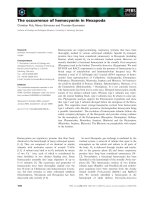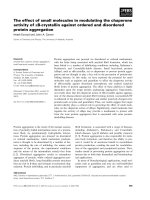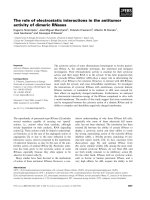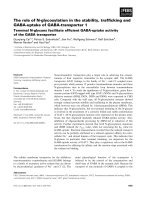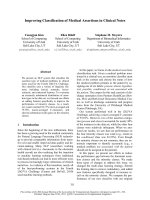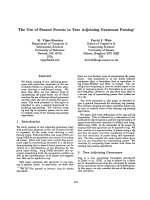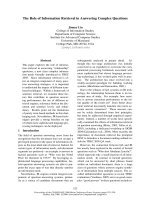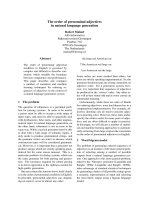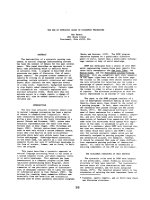Báo cáo khoa học: " THE DISTRIBUTION OF WORD LENGTH IN TECHNICAL RUSSIAN" pdf
Bạn đang xem bản rút gọn của tài liệu. Xem và tải ngay bản đầy đủ của tài liệu tại đây (118 KB, 3 trang )
[
Mechanical Translation
, vol.1, no.3, December 1954; pp. 38-40]
THE DISTRIBUTION OF WORD LENGTH IN TECHNICAL RUSSIAN
Anthony G. Oettinger
Computation Laboratory, Harvard University
IN the course of an analysis of several sam-
ples of technical Russian undertaken as part of
a study in mechanical translation, a number of
statistical data reflecting the structure of these
samples were compiled. One of these, the dis-
tribution of word length, is presented here as
Fig. 1.
The theoretical interest of this distribution
arises from the possibility of using it as a
basis for an operational definition of words in
printed texts. If texts are considered purely as
sequences of symbols including the letters,
punctuation marks, and space, the resulting se-
quences are of a length which no practicable
machine can manage. A study of the distribu-
tion of the number of symbols between pairs of
successive symbols of certain classes would be
one way to reveal structural characteristics of
the text sequences potentially useful toward the
definition of manageable and significant
subsequences. The subsequences included be-
tween successive occurrences of letter pairs
have not been investigated. Those included be-
tween successive pairs of periods, exclamation
points or question marks can be identified with
the classical sentence, and finally, those
included between successive pairs of punctua-
tion marks or spaces can be identified with
words. The length distribution of the latter
subsequences has the desirable property, not
shared by the others, of being concentrated at
relatively low values of length, and of having
no elements exceeding a certain length (Fig. 1).
Words, defined in this fashion, can readily be
identified by a machine and they are of limited
variety, so that their listing in a dictionary is
practicable.
From the practical point of view, the distri-
bution is useful in planning input and storage
facilities in experimental translating equip-
ment.
The samples used were relatively small, and
Fig. 1 should therefore be interpreted with
great caution. The bar graph represents the
distribution of a sample totalling 6,486 words.
Points are used to indicate the distributions
obtained from smaller constituents of the total.
The scattering is such as to indicate that sam-
ples 1, 2, and 3 differ significantly among each
other in details of their distributions. An ex-
amination of the texts indicates that these dif-
ferences can safely be attributed to differing
subject matter and styles. However, all distri-
butions are bimodal, perhaps trimodal, and cut
off at k=18. The mode about k= 7 is attributable
to the large number of different words used to
define the particular subject of each text. The
peaks at k= 1 and at k= 3 are due to a small
number of very frequent "grammatical words,"
that is, prepositions, conjunctions, etc. The
five most frequent words of length 1, 2, and 3
in the total sample are listed in Table 1. This
table shows that the most frequent two letter
words are consistently less frequent than three
letter words of similar rank. One and two letter
words are exclusively grammatical; 90% of the
three letter words are also grammatical,
leaving 10% dependent on the subject matter.
The words of length 4 are nearly all inflected.
The fact that only very few Russian words have
stems of three or less letters probably accounts
for the valley at k= 4. Indications thus are that
the modal and cut-off structure of the distribu-
tions are functions of the structure of the Rus-
sian language, while variations within these
structures are characteristic of individual au-
thors. For those who might wish to draw their
own conclusions, the raw data is given in Table
2, and the sources of the samples are listed in
Table 3. Letter, diagram and suffix distribu-
tions compiled from the same samples may be
found in the reference.
TABLE 1
v 210 na 86 pri 93
i 165 iz 57 dlja 72
s 91 po 46 chto 50
k 43 ot 28 kak 29
a 21 ne 26 ili 22
38
THE DISTRIBUTION OF WORD LENGTH IN TECHNICAL RUSSIAN
39
k (LENGTH in LETTERS)
Figure 1
40 ANTHONY G. OETTINGER
TABLE 2
Word Frequency
length
Sample Sample Sample Sample Total
1 2 3a 3b
1 67 204 178 88 537
2 36 147 114 54 351
3 40 170 148 80 438
4 43 130 107 45 325
5 74 203 183 117 577
6 61 258 161 99 579
7 89 332 245 129 795
8 49 209 212 121 591
9 49 209 211 88 557
10 31 281 138 67 517
11 17 208 118 66 409
12 25 127 98 47 297
13 18 94 72 41 225
14 20 50 29 10 109
15 5 54 28 13 100
16 4 28 16 5 53
17 2 5 9 4 20
18 0 0 5 1 6
TABLE 3
1.
A. G Lunts, 1950, "Prilozhenie Matrichnoj
Bulevskoj Algebry k Analizu i Sintezu
Relejno-Kontaktnyx Sxem," Doklady Akade-
mii Nauk SSSR, 70, pp. 421-23.
2.
K. V. Valdimirskij, 1951, "O Sinxronnom
Fil'tre," Zhurnal Eksperimental'noj i
Teoreticheskoj Fiziki,
21,
pp. 2-10.
3.
B. P. Aseev, 1947, Osnovy Padiotexniki
(Moskva: Svjaz'izdat) (a) pp. 10, 18, 20, 21,
23, 33, 37, 42, 45, 49, 55 (part); (b) pp. 55
(part), 59, 64, 65, 71, 122
REFERENCE
Oettinger, A. G., "A Study for the Design of an
Automatic Dictionary," Doctoral Thesis, Har-
vard University (1954).
